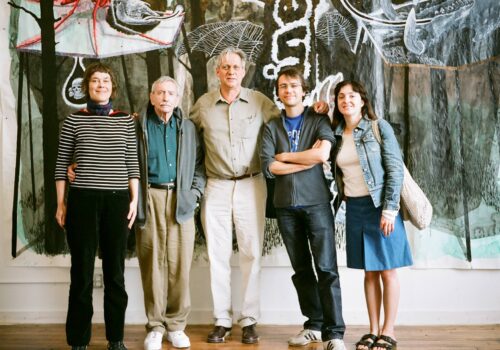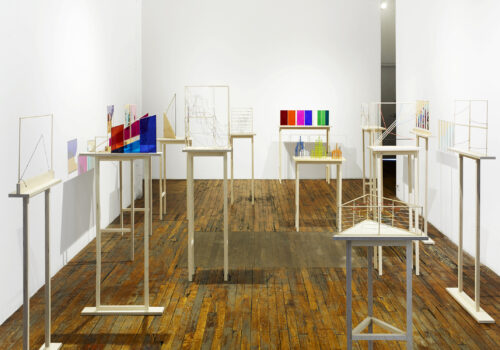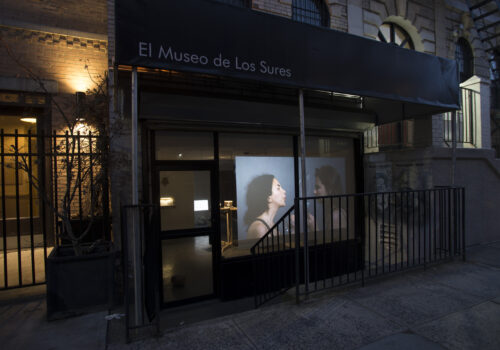This in an interview with Founder and former Director of the International Studio & Curatorial Program and current board member Dennis Elliott, by Director of Development and Programs Manager, Juliana Cope.
Juliana Cope (JC): Can you describe ISCP’s first Open Studios? When and where was it and why did you hold it? Who came and how did you promote it?
Dennis Elliott (DE): The first Open Studios was in the fall, 1994 at ISCP (then known as ISP) in a half-empty warehouse on Greenwich St. in Lower Manhattan’s TriBeCa.
It was memorable as there were only three artists exhibiting in their studios. With no common area to mount an exhibition, the studios seemed to be the only possible venue to present the artists’ work. Showing work in progress was a logical evolution given the mission of an artist-in-residence program.
The Open Studios were mandatory as the sponsors wanted their artists to have exposure to the New York art community. Implementing Open Studios, Visiting Critics, Salons and Field Trips were not only desirable program initiatives but were part of the contractual agreement with the sponsors.
For the first Open Studios (and for many years after), I mailed invitations with personal messages. It now seems quaint with the onslaught of social media. However, my demanding, “You must come!” on each invite actually worked. The participating artists designed the invites, which gave them more ownership of the event. The mailing list was only a couple of hundred names, compiled while I was administrating two other studio programs and with the contacts made during the first ten months of ISCP’s existence….
I would guess that about 150 attended the first Open Studios. Having hosted other Open Studios in the past, I was aware of the allure of refreshments—in my enthusiasm, I went to the absurd length of roasting turkeys and hams in my apartment the night before.
November 1994 was the beginning of my ISCP Open Studios learning curve. While this foray into inviting the public was somewhat clumsy, it was also very heady and loaded with promise….
JC: ISCP has held Open Studios in various locations as it moved from TriBeCa to Midtown to Brooklyn. Have you noticed any interesting differences based on the building and studio spaces?
DE: Physically and aesthetically, the TriBeCa and East Williamsburg buildings were similar. I was drawn to both for—among other things—the skylights allowing light and air into the central footprint, which was critical in affording more studio space and making the program viable.
Both buildings had their charm. And, both were secured in a down market with extremely advantageous leases. The real estate gods smiled on me during the TriBeCa-lease negotiation. The bursting of the dot-com bubble had pretty much emptied the building. That and an ingénue managing agent’s first negotiation were unexpected gifts that allowed ISCP to be born in an enormous top-floor with practically no capital.
Similarly, after viewing over 100 potential but unsatisfactory new homes for ISCP in 2007, a marathon lease negotiation resulted in ISCP’s move into an ideal facility in East Williamsburg. Again, favorable terms allowed ISCP to thrive. So much so that we were able to expand by developing another floor at the depth of the 2008 recession.
However, our Midtown experience was fraught from the beginning with facility and lease issues. It was a mostly difficult seven years for ISCP. The silver lining was that it forced ISCP to stand on its own, form a 501 (c) (3) and nurture the beginnings of what has become an exceptional board.
My concern for moving ISCP to Brooklyn was alleviated, once I discovered that NYC’s art community had preceded us. Being a stone’s throw from Bushwick compensated for our loss of the walking-access to Chelsea we had when we were on West 39th St. Also, moving into much larger, less expensive facilities allowed us to dedicate a decent amount of space for common areas, a gallery and a project room, thus permitting exhibitions, lectures, panels, conferences and the ability to provide space to academic institutions and other nonprofit organizations. This added a whole new dimension to the program, increasing ISCP’s visibility and community involvement.
Acting as a community resource was not really possible during ISCP’s fourteen years in Manhattan. Of the many things that excited me about the move to Brooklyn, having a community to work with and being appreciated by it, were at the top of the list.
Our current facilities have allowed ISCP to enhance its appeal and its work. The spacious studios, curatorial offices, open and efficient office spaces for the staff, common areas, three kitchenettes, bathrooms on every floor and ample storage area have helped make ISCP a destination for art professionals from all over the world.
JC: Who were some of the most noteworthy Open Studios visitors throughout the years and what bonds were forged with them?
For me, the most noteworthy Open Studios visitors were to be found in two categories: sponsors/potential sponsors and the diplomats/bureaucrats (mostly from the consulates and embassies in NYC and Washington DC). At many Open Studios: conversations were initiated, proposals were made and, best of all, deals were struck.
Four that stood out were Anne Garneau, the great Cultural Attaché at the Canadian Consulate, who attended Open Studios many times and worked tirelessly to bring Canadian residents to the program, and who even procured funds from her communications budget in support of this initiative. Likewise, Jacques Soullilou, Cultural Attaché of the French Embassy, who deserves credit for attracting support from the French Cultural Institute for artists’ residencies at ISCP. Third, Francis Greenburger, who founded and built a major real estate company New York, has been a longtime supporter and sponsor of ISCP. Just after 2002, Francis and I even tried to initiate an ISCP outpost in Montreal, but political changes at the time thwarted our efforts. Finally, Edward Albee, perhaps my favorite noteworthy visitor, would come to Open Studios and spend hours with the artists, most of whom had no idea who he was.
JC: From your position as a practicing artist what are the greatest values of Open Studio events?
DE: Open Studios can provide much desired feedback for the artists and curators. The event provides a broad spectrum of visitors and potential for career-altering encounters. There have been multiple connections made at the Open Studios that led to inclusion in exhibitions, invitations to travel and one-person shows. Other than that, it is really motivating to have an audience for your work and the subsequent exchange of ideas that can validate your efforts in the studio.
JC: ISCP used to be called ISP. Has having curators in residence changed the dynamics of ISCP’s Open Studios over the years?
DE: I always felt that curators do the greater good. If one thinks that curators have little support now to develop their practice, back in the 90s there was none. Even our core long-term sponsors were implacable then about not underwriting curators’ residencies. Finally after much exhortation, the Netherlands took the plunge in 1999.
Having curators in residence has been a potent stimulus for the program’s synergy. Just the exchange that goes on in the common rooms, studio visits, the programmed and social events have incalculable value. In addition, there are the outside influences the curators bring to the table: their research, writings, lectures, panels and exhibitions. The program’s mission is to nurture their practice and, in return, this experience can reap benefits for ISCP through association and visibility.
Having curators make presentations at the Open Studios by giving a preview of their research brings in work of artists not in residence, which adds a further dynamic to the event and the program.
JC: Do you know the history of Open Studios in New York City? Salons have been around for centuries but the idea of Open Studios is a little different. I am curious how you have seen this type of program change since the 1990’s.
DE: The New York art community is much larger, more commercial and just different than when I started administering programs in the early 1980s. At that time, one could almost know everyone…it was like a cottage industry. But, as thousands of young artists and curators poured into the city over the years, the art community grew exponentially.
Now, arts residencies have morphed into more professional and corporation-like structures, each with their own characteristics. ISCP has persistently maintained its support of artists and curators—that may seem an anomaly to many of the other art worlds that exist in New York.
The Open Studios are the most visible component of how ISCP has grown and diversified over the last 20+ years.
Note: This interview is edited and excerpted from a longer exchange that took place by email in March 2017.
Image:
Left to right: ISCP alumna Lene Berg, playwright Edward Albee, ISCP founder Dennis Elliott, ISCP alumni Damien Deroubaix and Valérie Mannaerts in 2008. Work by Deroubaix in the background.


